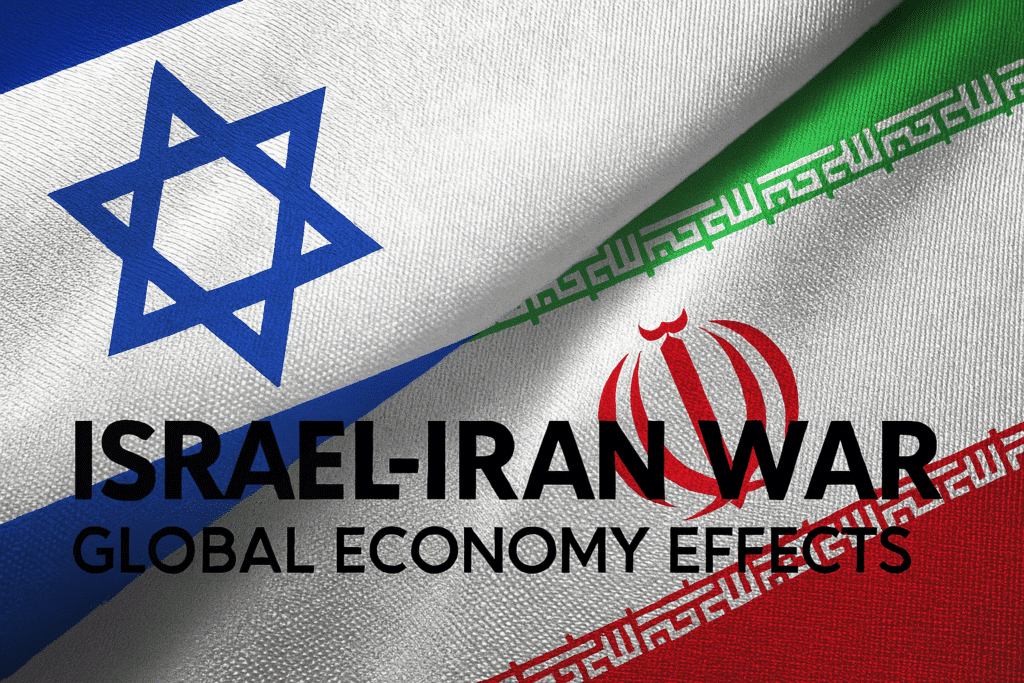Israel-Iran war global economy effects! On the morning of June 13, 2025, a headline broke that immediately shifted the global narrative: Israel had launched airstrikes on Iran’s nuclear facilities near Natanz and Fordow.
Within hours, Iran retaliated with missile strikes on Israeli military sites and infrastructure. What had long simmered as a high stakes regional rivalry suddenly erupted into direct conflict.
However, this conflict is not limited to the Middle East. Its shockwaves are already rattling the global economy, and the tremors are becoming more intense..
Oil Markets in Crisis
Prices are rising, and stability is decreasing.

The most immediate jolt has been felt in oil markets. Crude prices have spiked dramatically as fears over supply disruptions ripple across the globe.
In just four days, Brent crude surged from $86 to $132 per barrel. Iran has paused exports from major terminals in the Persian Gulf, and several oil tankers have either come under attack or been diverted away from the increasingly volatile Strait of Hormuz, a narrow waterway responsible for nearly a fifth of global oil trade.
For countries heavily reliant on imported oil, such as India, China, Japan, and much of Europe, the ripple effect is brutal: higher fuel prices, mounting inflation, and a tightening squeeze on both the transportation and manufacturing sectors.
Analysts warn that if this war widens or drags on, oil could spike beyond $150, setting off another global inflation spiral and pushing fragile economies toward recession.
Global Markets are in Trouble
Fear Rules the Day
- Investors are responding in the only way they know how: sell first, ask questions later.
- The Dow Jones Industrial Average has decreased by more than 1,500 points.
- Major indices like the FTSE 100, Nikkei, and DAX are down 3–5%.
- Emerging markets, especially those geographically or economically tied to the region, are seeing heavy outflows.
- The “fear index” (VIX) has increased above 40, showing a level of market anxiety similar to the chaos of early 2020. The atmosphere feels tense.
Business and Trade Hit Pause
From Expansion to Caution
Businesses in different sectors are now taking a cautious approach. Expansion plans, IPOs, and investments are being delayed or scrapped altogether. In the Middle East’s tech and logistics sectors, foreign investors are now stepping back significantly from areas that are already weak and vulnerable.
Shipping routes through the Strait of Hormuz, the Red Sea, and even the Suez Canal are now considered high risk zones. Naval escorts are increasing, marine insurance premiums have jumped 40%, and Global logistics is preparing for a new wave of disruption that could be worse than the Suez blockage in 2021.
Supply Chains: Déjà Vu
The Domino Effect Begins
The economic toll is already materializing in real-world shortages and delays:
- Semiconductors: Delays in critical raw materials.
- Automobiles: Rising costs for steel, plastics, and components.
- Pharmaceuticals: Active ingredients stuck in shipping limbo.
We are looking at another round of global supply chain snarls, just as many economies were beginning to recover from the last one.
Inflation: A Problem We Face Again
Consumers Are Feeling the Burn
For ordinary households, the pain is tangible:
- Fuel prices are up 10–25% worldwide.
- Airfare and shipping costs are climbing.
- Grocery bills are beginning to reflect the disruption.
Central banks now face a tricky balancing act: Do they raise interest rates to tame inflation or keep them low to protect growth? Either move carries significant risk. “Stagflation,” that dreaded mix of high prices and stagnant output, may be making a comeback.
Currencies and Safe Havens
Flight to Stability
Currencies across the region are taking a hit. The Israeli shekel is down more than 9%, the Iranian rial is sliding under renewed sanctions, and other regional currencies like the Turkish lira and Egyptian pound are feeling the pressure.
Meanwhile, investors are piling into traditional safe havens. Gold has surged past $2,250 an ounce. Bitcoin saw a short-lived rally, though its fate is volatile, particularly amid Iranian internet blackouts. The U.S. dollar, Swiss franc, and Treasury bonds are all seeing renewed demand.
Who is Feeling the Heat?
Here is a quick snapshot of how different regions are faring:
| Region | What’s Happening |
|---|---|
| Middle East | Defense budgets soaring, trade collapsing, refugees rising |
| Europe | Energy prices jumping, economic recovery under threat |
| South Asia | Oil driven inflation in India, Pakistan, and Bangladesh |
| Africa | Food and fuel shortages in import-heavy nations |
| China & Japan | Oil-driven inflation in India, Pakistan, and Bangladesh |
What Comes Next? Three Scenarios
1. Full-Scale Regional War
If Hezbollah, Syria, or even the U.S. get pulled in, expect oil at $160+, a global recession, and severe market disruption.
2. Prolonged Stalemate
A lingering standoff would keep markets in flux, destabilize trade, and prolong the inflation squeeze.
3. Ceasefire or Diplomatic Breakthrough
The best case outcome, likely with pressure from the UN, Gulf powers, or China would cool markets, begin stabilization, and kick off a slow road to recovery. Still, the scars would linger.
Conclusion
Israel Iran war global economy effects! This is no longer just a regional conflict. It is a full-blown economic event with worldwide implications. From gas stations to grocery stores, boardrooms to border crossings, the Israel-Iran war is altering everyday life. Even if peace is restored soon, the ripple effects are already locked in and reversing them will not be quick or easy.
In our interconnected world, one explosion in a region can quickly impact countries all over the globe. And that is exactly what we are seeing now.



